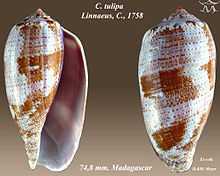Conus tulipa
| Conus tulipa | |
|---|---|
 | |
| Apertural and abapertural views of shell of Conus tulipa Linnaeus, C., 1758 | |
 | |
| Scientific classification | |
| Kingdom: | Animalia |
| Phylum: | Mollusca |
| Class: | Gastropoda |
| (unranked): | clade Caenogastropoda clade Hypsogastropoda clade Neogastropoda |
| Superfamily: | Conoidea |
| Family: | Conidae |
| Subfamily: | Coninae |
| Genus: | Conus |
| Species: | C. tulipa |
| Binomial name | |
| Conus tulipa Linnaeus, 1758 | |
| Synonyms[1] | |
|
Conus borbonicus H. Adams, 1868 | |
Conus tulipa is a species of sea snail, a marine gastropod mollusk in the family Conidae, the cone snails and their allies.[1]
Like all species within the genus Conus, these snails are predatory and venomous. They are capable of "stinging" humans, therefore live ones should be handled carefully or not at all.
A class of conopeptides named rho-TIA was discovered in Conus tulipa in 2001.[2] This class of conopetides targets (react with) alpha1-adrenergic receptors.[2]
Description
Conantokin-T is a toxin derived from the venom of Conus tulipa.
Distribution
Feeding habits
Conus tulipa preys on fishes.[2]
-

Conus tulipa Linnaeus, C., 1758
-

Conus tulipa Linnaeus, C., 1758
-

Conus tulipa Linnaeus, C., 1758
References
- ↑ 1.0 1.1 1.2 1.3 1.4 Conus tulipa Linnaeus, 1758. Retrieved through: World Register of Marine Species on 27 March 2010.
- ↑ 2.0 2.1 2.2 Sharpe I. A., Gehrmann J., Loughnan M. L., Thomas L., Adams D. A., Atkins A., Palant E., Craik D. J., Adams D. J., Alewood P. F. & Lewis R. J. (September 2001). "Two new classes of conopeptides inhibit the alpha1-adrenoceptor and noradrenaline transporter.". Nature Neuroscience 4(9): 902-907.
External links
| Wikimedia Commons has media related to Conus tulipa. |